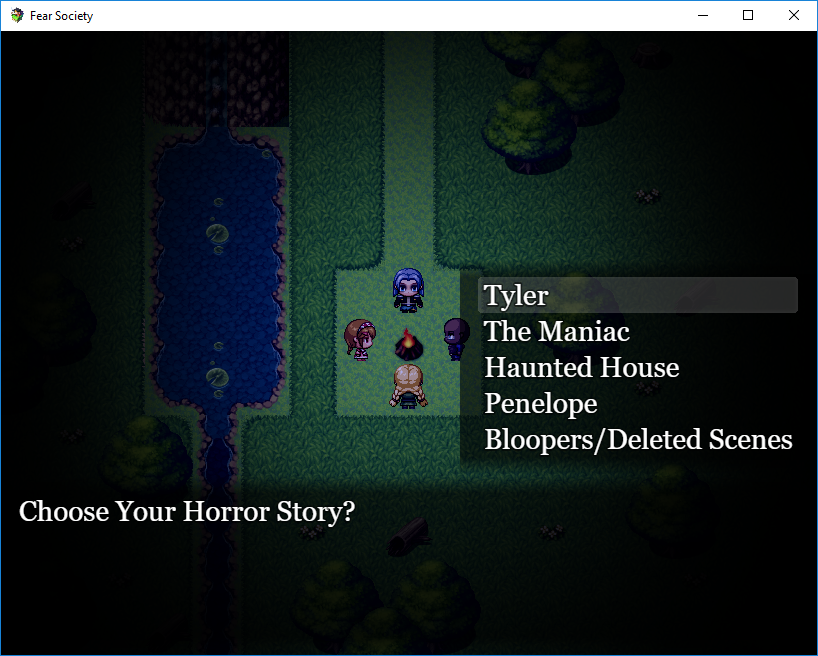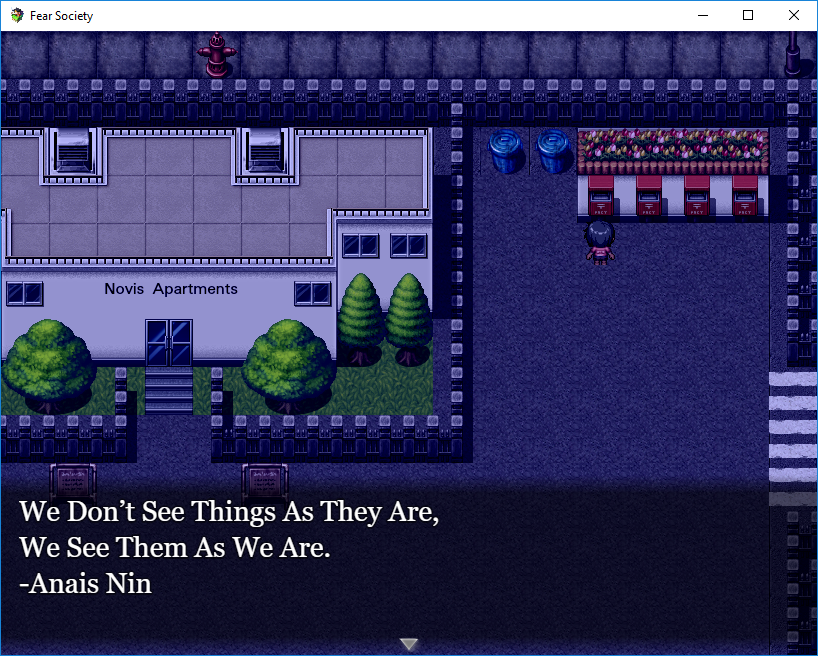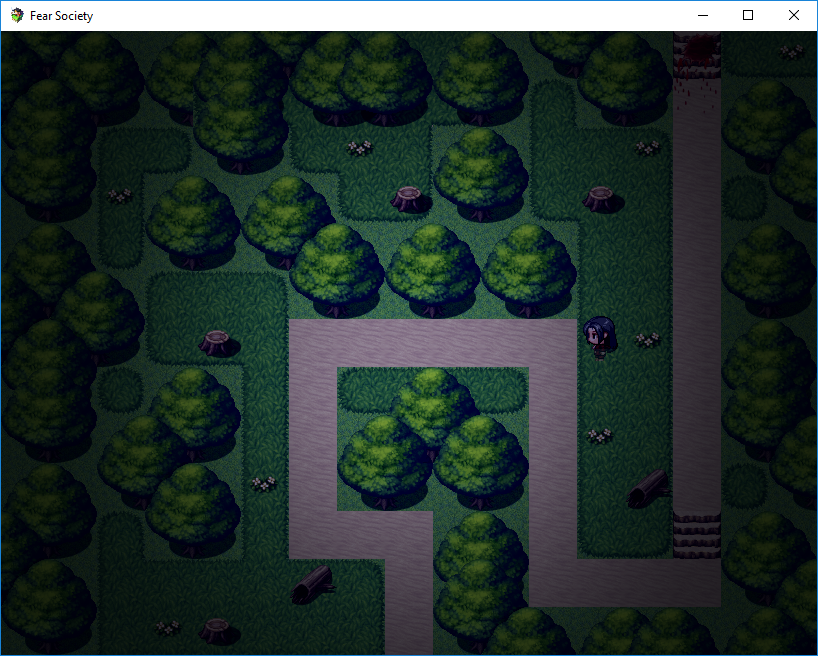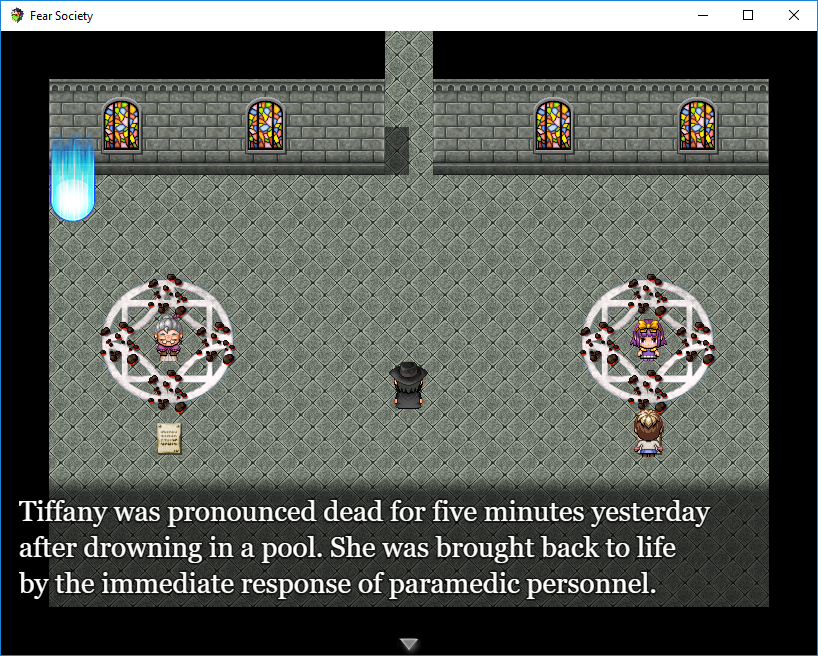 Add Review
Add Review Subscribe
Subscribe Nominate
Nominate Submit Media
Submit Media RSS
RSS
A decent stab at meta-horror
 NTC3
NTC3- 04/16/2018 10:09 PM
- 775 views
Pretty much anyone with any experience in the rmk scene knows that horror games are almost as, if not even more frequent than the JRPGs the engine is traditionally designed for. Often, they use the RTP as well, which worked better in the older releases with their darker, blurrier artstyle, but is much harder to do acceptably with the bright colours and chibi characters of the VX/MV era. However, ZeroDigitsZ managed to overcome these limitations in One of You, which had a narrative that was both entirely cohesive and sufficiently ambiguous to genuinely disturb.
Hence, I decided to check out his other games as well. Fear Society here is an earlier work, and it’s less ambitious as well. Rather than trying to disturb the player on the merits of a singular developed storyline, it plays around with typical horror clichés such as a haunted house or a dark, stalker-infested forest, by embedding them in the meta-narrative of four teens trying to scare each other with stories told around the campfire. It claims to be inspired by “Are You Afraid of the Dark?”, a long-gone TV show I heard of, but never saw. This immediately provides several benefits: a) clichés themselves become more tolerable, and plot holes and such are perfectly in line with some teen making it all up on the fly; b) since no individual horror story has to support an entire game by itself, they can be condensed, and freed of filler (as opposed to, say, the dozens of cloned classrooms of Mystery Dorm); c) you get the intro and outro where the narrator and the audience briefly introduce their story, discuss its ending, and drop incidental details about themselves. It’s nothing deep or groundbreaking, but it’s entirely believable and helps a lot to set the atmosphere.

You can see the four stories above, and the order in which they are listed is also pretty representative of their quality. Hence, Tyler has the most complex narrative, being about a woman who lost her child, the titular Tyler, in a park, and the initially straightforward goal of finding him is soon cast in an entirely different light by a twist, and then another, and another. Its item description is usually pedestrian (i.e. “Armoire” or “Mirror”) when compared to, say, games, though laptops always have their manufacturer (Asus, Dell, HP) stated in a weird move. However, it has quite a lot of secondary writing around the place, like notes from her landlord and neighbours, gossip magazines, etc. Some of them, like the note about neighbour’s cat, are valid plot beats in their own right.

Unfortunately, “Tyler” also suffers from the loosest mapping in the game, with reams of empty floor tile space indoors and lazily repeated interior elements around. In particular, notes left around doorways (i.e. “NO PETS ALLOWED” at the park entrance) will always be duplicated pointlessly, just so that the doorway can be framed symmetrically. The triggers for some plot events also don’t switch off and so can be triggered again and again (i.e. when you first enter Room 101), though it’s thankfully nothing gamebreaking. You are also not prevented from going to the Abandoned Warehouse early in the game, when there’s little-to-no plotline reason to do so, and it only serves to provide an early game over. (Which is rather questionable given later plot developments, but again, it is a fiction, even within the game itself.)
On the contrary, “The Maniac” has a polar opposite set of strengths and weaknesses. Its premise of two sisters being chased through forest trails by a maniac (who uses TDKR Bane faceset) is about as straightforward as it gets. As such, it’s brief and wisely on action, with a couple of decent chases set to original music in reasonably nice and tight maps. (Especially when compared to other attempts to make RTP forests scary, like the solid walls of trees in An Evil Night.) It has a genuine choice between two conventional endings as well, which is nice. In a way, the main similarity between these two episodes is how they both start with a scene that seems very reminiscent of Heavy Rain; searching for a child on the playground in the former, and audibly counting to a number (but with an option to cheat and skip to the end quickly) in the latter. There also some environmental elements repeated between the two: the car park is clearly the same for both, and you can find interactable drinking fountains in both stories, which is a nice touch.

The third and fourth episode are both a step below the first two, and are practically pure fluff. In Haunted House, the outcome is simply never in doubt, and there is no real character or story element to care about much. While the mapping is fine and there are a couple of decent puzzles (involving that old staple, dolls and numbers) in it, the whole thing still feels largely perfunctory. The fourth episode, Penelope, is built around an initiation ritual into a cult that collects your soul in exchange for a wish. That premise could’ve been pretty neat, but the end result is a completely unscary walk through a series of barren stone rooms to solve a couple of puzzles that never feel much like horror. (At one point, you can even partake in the elemental rock-paper-scissors, which has no deeper significance to it.) It does have one Telltale-like choice in the middle that doesn’t affect the story’s outcome, but still has some disturbing background. However, it’s ultimately too obvious (to the point it’s almost a parody) and nothing else is memorable.

After you’ve seen at least one of the stories, Skip to Voting appears in the menu. Besides letting you express your opinion about the stories in question, it also has an additional, much darker function, courtesy of the meta-narrative. You can access bloopers/deleted scenes as well, which is pretty entertaining after you finish the game.
Conclusion
In all, Fear Society is a reasonable early horror effort. I ultimately liked playing through it, especially as it was clear how some elements there were later built up on in One of You. A demo for the sequel has become available recently as well, and I’ll be playing it next, hopefully witnessing multiple improvements.
Hence, I decided to check out his other games as well. Fear Society here is an earlier work, and it’s less ambitious as well. Rather than trying to disturb the player on the merits of a singular developed storyline, it plays around with typical horror clichés such as a haunted house or a dark, stalker-infested forest, by embedding them in the meta-narrative of four teens trying to scare each other with stories told around the campfire. It claims to be inspired by “Are You Afraid of the Dark?”, a long-gone TV show I heard of, but never saw. This immediately provides several benefits: a) clichés themselves become more tolerable, and plot holes and such are perfectly in line with some teen making it all up on the fly; b) since no individual horror story has to support an entire game by itself, they can be condensed, and freed of filler (as opposed to, say, the dozens of cloned classrooms of Mystery Dorm); c) you get the intro and outro where the narrator and the audience briefly introduce their story, discuss its ending, and drop incidental details about themselves. It’s nothing deep or groundbreaking, but it’s entirely believable and helps a lot to set the atmosphere.

You can see the four stories above, and the order in which they are listed is also pretty representative of their quality. Hence, Tyler has the most complex narrative, being about a woman who lost her child, the titular Tyler, in a park, and the initially straightforward goal of finding him is soon cast in an entirely different light by a twist, and then another, and another. Its item description is usually pedestrian (i.e. “Armoire” or “Mirror”) when compared to, say, games, though laptops always have their manufacturer (Asus, Dell, HP) stated in a weird move. However, it has quite a lot of secondary writing around the place, like notes from her landlord and neighbours, gossip magazines, etc. Some of them, like the note about neighbour’s cat, are valid plot beats in their own right.

Unfortunately, “Tyler” also suffers from the loosest mapping in the game, with reams of empty floor tile space indoors and lazily repeated interior elements around. In particular, notes left around doorways (i.e. “NO PETS ALLOWED” at the park entrance) will always be duplicated pointlessly, just so that the doorway can be framed symmetrically. The triggers for some plot events also don’t switch off and so can be triggered again and again (i.e. when you first enter Room 101), though it’s thankfully nothing gamebreaking. You are also not prevented from going to the Abandoned Warehouse early in the game, when there’s little-to-no plotline reason to do so, and it only serves to provide an early game over. (Which is rather questionable given later plot developments, but again, it is a fiction, even within the game itself.)
On the contrary, “The Maniac” has a polar opposite set of strengths and weaknesses. Its premise of two sisters being chased through forest trails by a maniac (who uses TDKR Bane faceset) is about as straightforward as it gets. As such, it’s brief and wisely on action, with a couple of decent chases set to original music in reasonably nice and tight maps. (Especially when compared to other attempts to make RTP forests scary, like the solid walls of trees in An Evil Night.) It has a genuine choice between two conventional endings as well, which is nice. In a way, the main similarity between these two episodes is how they both start with a scene that seems very reminiscent of Heavy Rain; searching for a child on the playground in the former, and audibly counting to a number (but with an option to cheat and skip to the end quickly) in the latter. There also some environmental elements repeated between the two: the car park is clearly the same for both, and you can find interactable drinking fountains in both stories, which is a nice touch.

The third and fourth episode are both a step below the first two, and are practically pure fluff. In Haunted House, the outcome is simply never in doubt, and there is no real character or story element to care about much. While the mapping is fine and there are a couple of decent puzzles (involving that old staple, dolls and numbers) in it, the whole thing still feels largely perfunctory. The fourth episode, Penelope, is built around an initiation ritual into a cult that collects your soul in exchange for a wish. That premise could’ve been pretty neat, but the end result is a completely unscary walk through a series of barren stone rooms to solve a couple of puzzles that never feel much like horror. (At one point, you can even partake in the elemental rock-paper-scissors, which has no deeper significance to it.) It does have one Telltale-like choice in the middle that doesn’t affect the story’s outcome, but still has some disturbing background. However, it’s ultimately too obvious (to the point it’s almost a parody) and nothing else is memorable.

After you’ve seen at least one of the stories, Skip to Voting appears in the menu. Besides letting you express your opinion about the stories in question, it also has an additional, much darker function, courtesy of the meta-narrative. You can access bloopers/deleted scenes as well, which is pretty entertaining after you finish the game.
Conclusion
In all, Fear Society is a reasonable early horror effort. I ultimately liked playing through it, especially as it was clear how some elements there were later built up on in One of You. A demo for the sequel has become available recently as well, and I’ll be playing it next, hopefully witnessing multiple improvements.












